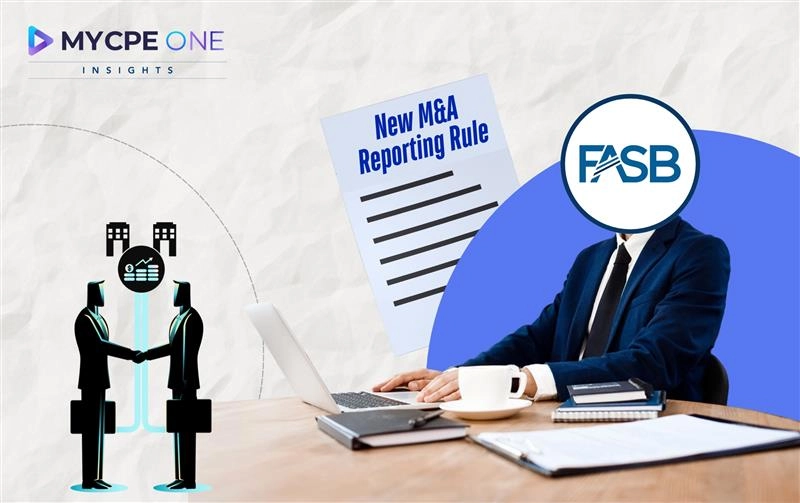


Join 250,000+
professionals today
Add Insights to your inbox - get the latest
professional news for free.

Join our 250K+ subscribers
Join our 250K+ subscribers
Subscribe14 MAY 2025 / FASB REPORTING

The Financial Accounting Standards Board (FASB) has issued new guidance under ASU 2025-03 that changes the rules governing business combinations and consolidations, with a specific focus on variable interest entities (VIEs). The revision enables companies to use economic reality rather than rigid definitions to identify the accounting acquirer in mergers, leading to more accurate financial reporting especially in deals involving VIEs, LLCs, Up-C structures, and SPAC mergers.
Ever seen a merger where the “acquired” company somehow ends up calling the shots? Welcome to accounting’s version of “Who’s the boss?” And thanks to FASB’s new guidance under ASU 2025-03, that mystery just got a little more logical, and a lot fairer. This update shakes up the rules in FASB Topic 805 (Business Combinations) and Topic 810 (Consolidations), especially when variable interest entities (VIEs) are involved. The big idea? Let economic reality, not rigid rules, decide who the true accounting acquirer is.
Let’s break it down. When companies merge, figuring out who the accounting acquirer is shapes the entire future of their financial reporting. The acquirer keeps its books as-is, while the acquiree’s assets and liabilities get remeasured, usually at fair value. That can lead to goodwill spikes, asset markups, and big shifts in net income. Previously, if a VIE was in play, Topic 810 forced the primary beneficiary to be the acquirer—no ifs, ands, or equity swaps. That meant two identical deals could get different treatment on the books, simply because one entity had VIE status. Richard Jones, FASB Chair, called this out, stating: “This ASU makes financial reporting more comparable and decision-useful for investors.” Translation: we're finally ditching the one-size-fits-all rulebook.
Under ASU 2025-03, if a VIE is the legal acquiree and the deal is primarily equity-based, companies no longer default to the “primary beneficiary is always the acquirer” rule. Instead, they must now apply five qualitative factors from 805-10-55-12 to 55-15 to figure out who’s really in control:
This shift makes the process more substance over form, especially helpful in today’s landscape of LLCs, Up-C structures, and SPAC mergers, which often involve VIEs. It’s about time accounting caught up to modern M&A.
Under the old rules, reverse acquisitions, where the legal acquirer is the accounting acquiree, weren’t even an option if a VIE was involved. Not anymore. ASU 2025-03 says: if the facts fit, call it what it is. This opens the door for more accurate financial storytelling, especially in transactions where private companies merge with SPACs or public shells but retain real control post-merger. Case in point: Under the new guidance, a target VIE with voting control post-deal might be labeled the accounting acquirer, even if they were technically “acquired”. Now, Up-C deals and equity-heavy de-SPACs get the treatment they deserve, aligning books with business logic.
Let’s clear the air: this isn’t a blanket change. The new rules only apply when:
So, if the VIE isn’t a business or the deal’s structured with cash or liabilities, the old rules still apply—primary beneficiary = acquirer. This scope helps FASB maintain clarity while avoiding unintended consequences. Stakeholders even suggested broader changes, but the Board kept it tight to avoid complexity creep
This isn’t some footnote update buried in the back of your GAAP binder. It’s a realignment of power in purchase accounting. Financial statements will now better reflect who’s truly driving the bus, not just who footed the bill.
Key Details You Need to Know:
If your deal structure involves a VIE and equity exchange, this is your cue to:
This ASU levels the playing field. No longer does the mere label of a VIE force accounting hands. The focus shifts to actual control and economic influence, improving comparability across public companies, private equity firms, and even emerging SPACs. Plus, it brings U.S. GAAP closer to IFRS 3, which already applies similar substance-based logic without hardwiring the primary beneficiary as the acquirer. The release of ASU 2025-03 isn’t just a standards tweak; it’s a mindset reset. If your team is navigating a deal involving a VIE, this update could be the difference between transparent financial reporting and a head-scratching mismatch. So, here’s your call to action: Dust off those merger models. Chat with your CFO. And make sure your next deal doesn’t tell the wrong story. Want to dive deeper into the official standard? Check out the ASU 2025-03 release from FASB here. Get the latest in tax, finance, and policy straight to your inbox—join the MYCPE ONE Insights newsletter.
Until next time…
Don’t forget to share this story on LinkedIn, X and Facebook
📢MYCPE ONE Insights has a newsletter on LinkedIn as well! If you want the sharpest analysis of all accounting and finance news without the jargon, Insights is the place to be! Click Here to Join
Scale Your Accounting Firm the Smart Way with MYCPE ONE!
Your Trusted Offshore Partner for CPAs and Accounting Firms.
Struggling to scale? Let MYCPE ONE’s offshore accounting team help you grow faster and more efficiently.
With 500,000+ vetted professionals across 40 offices in 2 countries, we provide you access to top talent and advanced technology, all while handling the hiring process for you.
Trusted by 3,000+ firms, including 45+ BDO Alliance Firms and 40+ of the Top 200 Accounting Firms!
Start building your offshore dream team today with MYCPE ONE!
Scale smarter. Save bigger. Stay ahead.